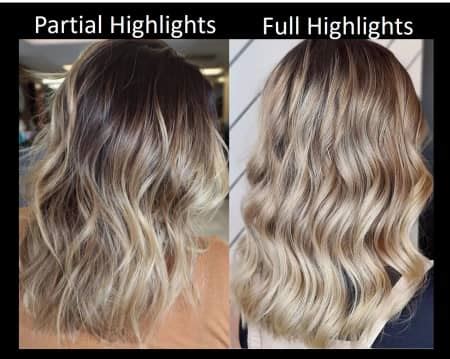Introduction

Achieving the perfect hair highlight can elevate your hairstyle and enhance your overall appearance. However, there are two main highlighting techniques to consider: partial highlight and full highlight. This article provides an in-depth comparison of both methods, empowering you to make an informed decision for your specific hair goals.
Partial Highlight
- Definition: Involves applying highlights to selected sections of the hair, typically focusing on the crown and framing areas.
-
Benefits:
- Creates depth and dimension by adding color to specific areas.
- Enhances texture and volume by lightening select strands.
- Less damaging than full highlights as it targets only certain portions of the hair.
Full Highlight
- Definition: A technique that involves applying highlights throughout the entire hair, from the roots to the ends.
-
Benefits:
- Provides an overall lightening effect, creating a brighter, more vibrant appearance.
- Refreshes and brightens the entire hair, removing dullness and brassiness.
- Can be customized to achieve specific effects, such as ombre or balayage.
Comparison Table
| Feature | Partial Highlight | Full Highlight |
|---|---|---|
| Coverage | Selected sections | Entire hair |
| Dimension | Adds depth and texture | Brightens overall |
| Damage | Less damaging | More damaging |
| Cost | Generally lower | Generally higher |
| Maintenance | Less frequent | More frequent |
How to Choose the Right Technique
The best highlighting technique for you depends on your desired results, hair type, and maintenance preferences:
- Partial highlight: Ideal for subtle changes, adding volume, or framing the face.
- Full highlight: Suitable for a bolder, brighter look, rejuvenating dull hair, or achieving specific effects.
Common Mistakes to Avoid:
- Overcoloring: Use toner to avoid brassy or yellow tones.
- Unnatural placement: Avoid placing highlights too close to the roots or in clumps.
- Leaving roots too dark: Ensure a smooth transition from roots to highlighted areas.
- Improper timing: Follow recommended development times to prevent damage.
Effective Strategies:
- Consult a professional: Seek expert advice on the best technique for your specific hair.
- Use high-quality products: Invest in professional-grade hair dyes and bleaching agents.
- Protect your hair: Apply a deep conditioner after highlighting to nourish and repair damaged strands.
- Maintain your highlights: Follow a regular toning and touch-up schedule to keep highlights vibrant.
Step-by-Step Approach
Partial Highlight
- Section the hair into desired areas for highlighting.
- Apply bleach or color to the selected sections.
- Use foils or plastic wrap to isolate the highlighted areas.
- Develop the color according to the manufacturer’s instructions.
- Rinse and condition the hair.
Full Highlight
- Section the hair into smaller pieces.
- Apply bleach or color to the roots of each section.
- Use foils or plastic wrap to cover the highlighted areas.
- Pull the hair through the foils or wrap to distribute the product.
- Develop the color according to the manufacturer’s instructions.
- Rinse and condition the hair.
Conclusion
Whether you choose partial or full highlights, it’s crucial to consider your hair goals, maintenance capabilities, and the expertise of your stylist. By following these tips and using effective strategies, you can achieve the perfect highlighted look that enhances your hair and boosts your confidence.
